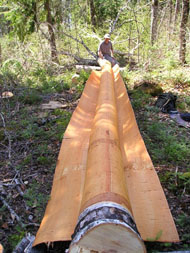
Birchbark canoe building is a fairly complex process, though in concept it is simplicity itself. It holds a couple of surprises for people unacquainted with it. One is that the birchbark is always used inside out on the canoe, with the rough white side facing in toward the planking and ribs, and the smooth inside surface, yellow in color, facing out. The other surprise is that unlike wood and canvas canoes, which are built by assembling the framework over a form and later covering it with a canvas skin, birchbark canoes are built from the outside in, with the ribs and planking added almost last.
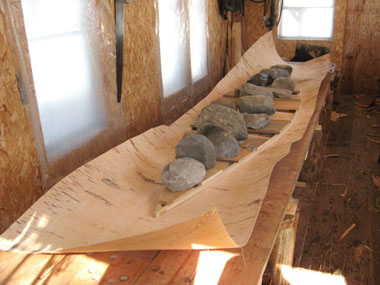 The gunwale frame is weighted on the bark to serve as a form for the bottom of the canoe.
The gunwale frame is weighted on the bark to serve as a form for the bottom of the canoe.The bark skin is first completely laid out and sewn up with spruce roots, on a smooth bed of dirt or wood, and the gunwales attached, thus forming an empty envelope of bark. This envelope is then shaped and stretched by tucking the ribs under the gunwales and driving them tight against the bark, with the planking sandwiched in between.
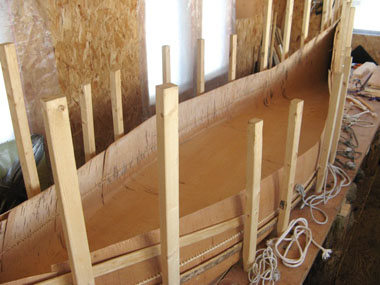 The sewing is completed on the sides of the bark, and the gunwale frame is removed, to be raised to sheer height.
The sewing is completed on the sides of the bark, and the gunwale frame is removed, to be raised to sheer height.The woodwork is made primarily of Northern White Cedar, which I select in the woods, split by hand, and then work into canoe members, primarily with hand tools, such as the traditional “crooked knife.” I also use a few power tools when the quality of the work will not be compromised.
The bark, which has been rolled up for storage, and then soaked prior to use, is unrolled on the building platform, outer side up. During the unrolling process hot water is poured on the bark to make it more pliable. The loose outer layers are removed. The sheet of bark is centered on the platform and the assembled gunwale frame (made of white cedar gunwales with rock maple thwarts mortised in and pegged with maple pegs) is placed on it and weighted down temporarily with boards and stones. A series of cuts or gores are made in the edges of bark protruding beyond the sides of the gunwale frame, and then the bark is again treated with hot water and the sides are folded up and held in place with stakes and battens. The gores are then stitched with boiled split red spruce root, and any additional pieces of birchbark needed for width on the sides are sewn in place, also with spruce root. I use “winter bark” for these side panels, as it can later be etched with designs.
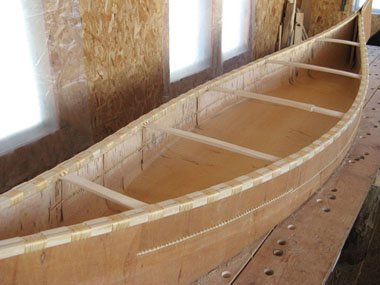 The inwales and outwales are fastened to the bark with pegs and spruce root lashings; the canoe is nearly ready for ribs.
The inwales and outwales are fastened to the bark with pegs and spruce root lashings; the canoe is nearly ready for ribs.The weights are then removed and the gunwale frame is raised to sheer height and placed on temporary posts, and the weights replaced. Outer gunwales, also of cedar, are placed alongside the inner gunwales with the bark sides sandwiched between.
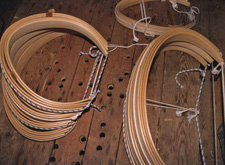
The gunwale assembly is pegged with maple pegs and lashed with spruce root. The weights, posts, and stakes are then removed, and the canoe is turned over on horses, and the ends are sewn together, using an inner stem-piece made of cedar which has been split into laminations, bent using boiling water, and then wrapped with cloth before being sewn into place. The canoe is then placed upright on a bed of cedar shavings in preparation for ribbing.
 After ribbing, the gunwale caps or top rails are pegged in place and lashed at the ends.
After ribbing, the gunwale caps or top rails are pegged in place and lashed at the ends.The inside of the canoe is now lined with cedar planking running lengthwise, which is held in place with pre-bent cedar ribs which are driven into place inside the planking and under the gunwales. Throughout this process, boiling water is constantly poured over the entire bark from the outside of the canoe, to heat and wet the bark so it will be as pliable as possible.
This is because the bark must be forced from a square cross-section to a rounded shape, with all slack stretched out of the bark, by means of the pressure of the ribs. When the ribbing is complete, cedar gunwale caps are pegged and lashed to the top of the gunwales, and two headboards are installed in each end of the canoe. All seams are then gummed with a mixture of pine rosin and lard, and the canoe is oiled inside and out with tung oil.
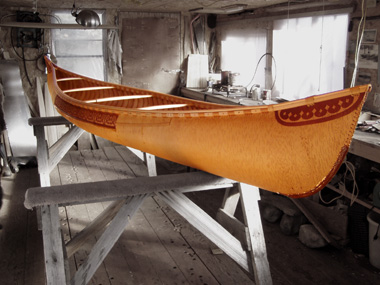 Finished Canoe.
Finished Canoe.

